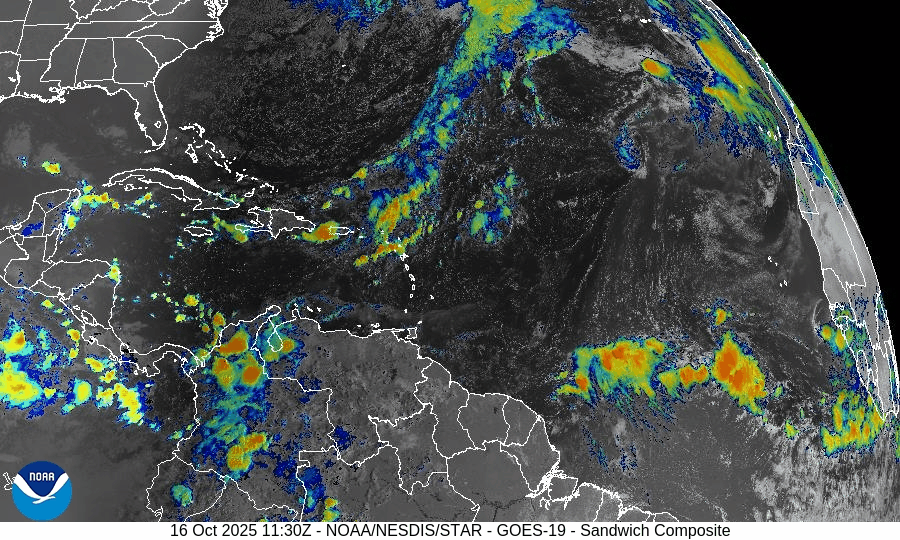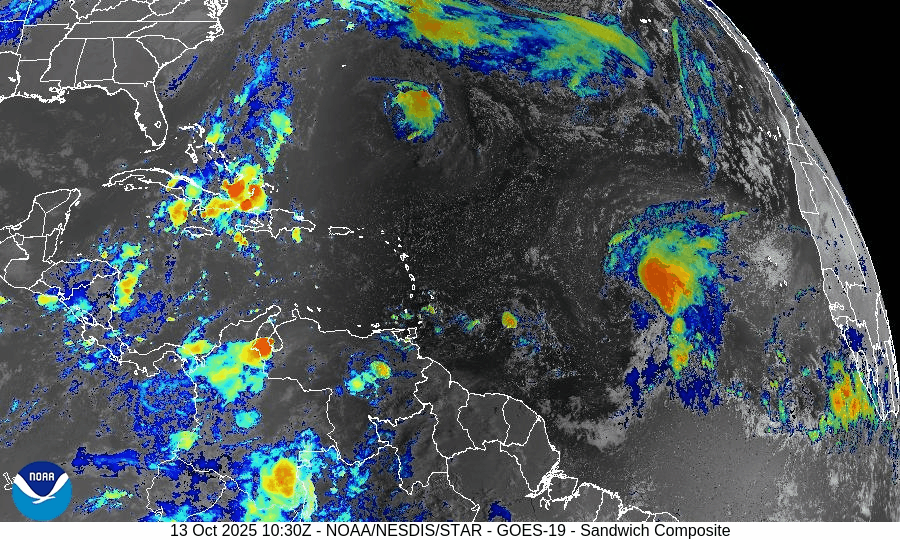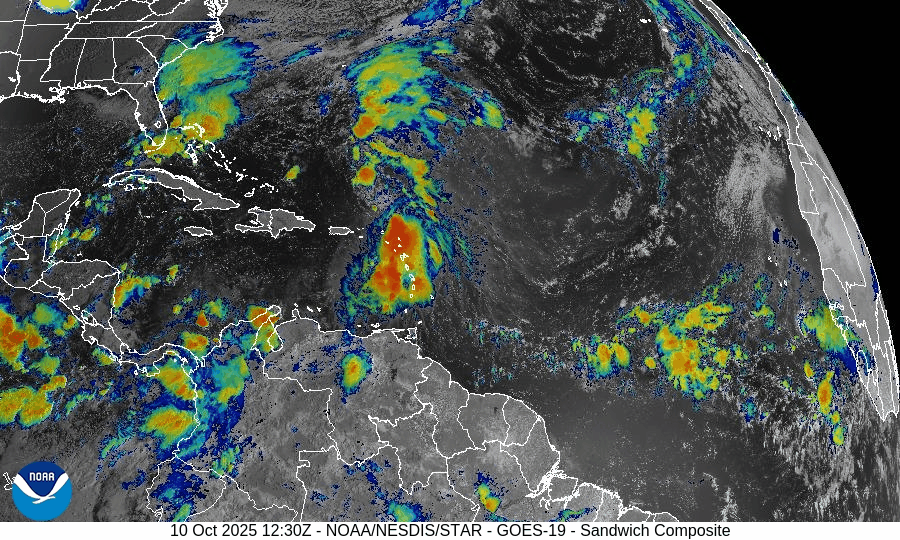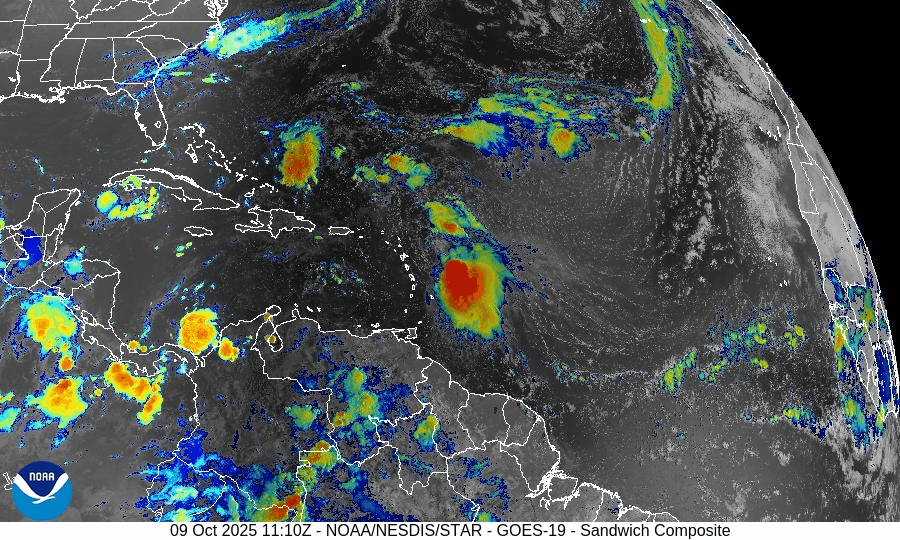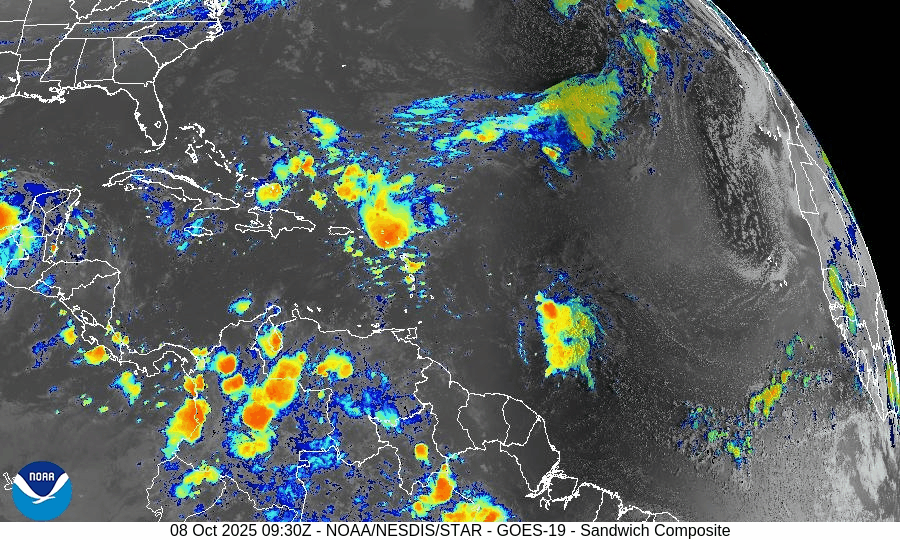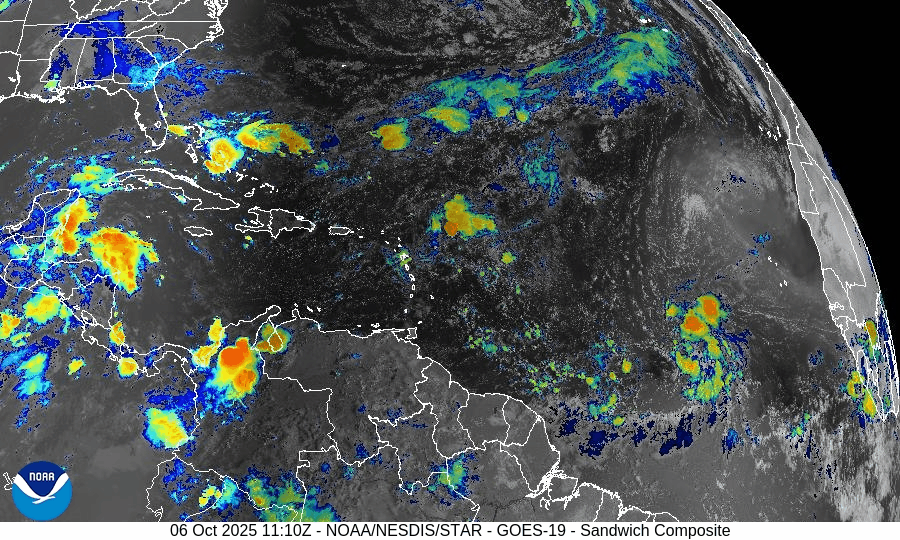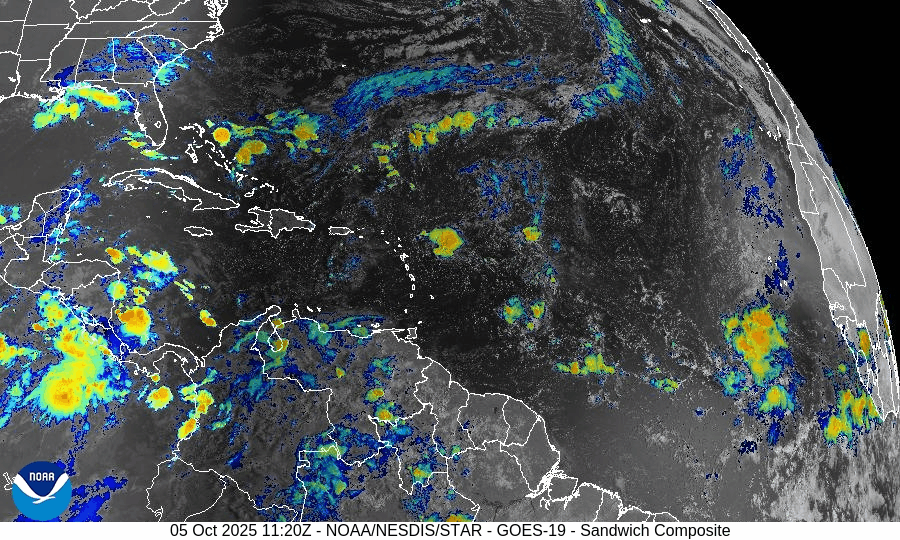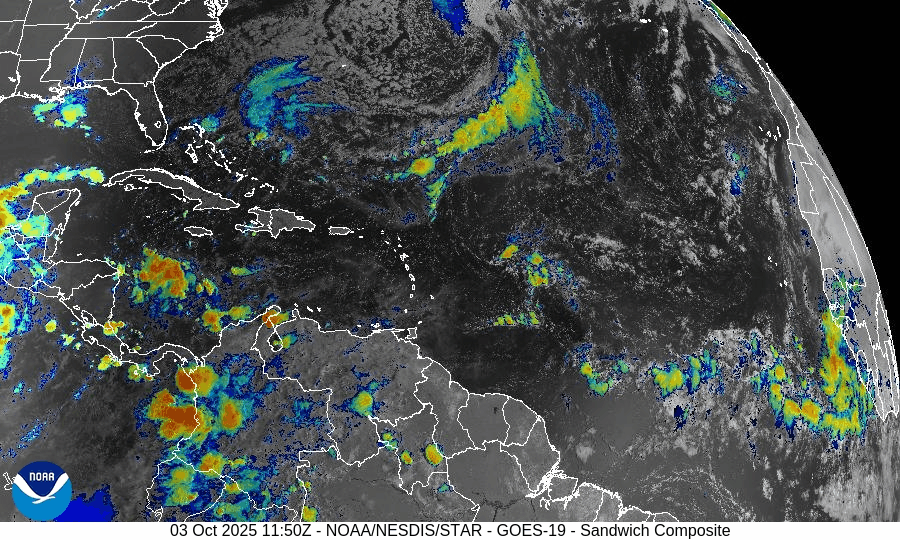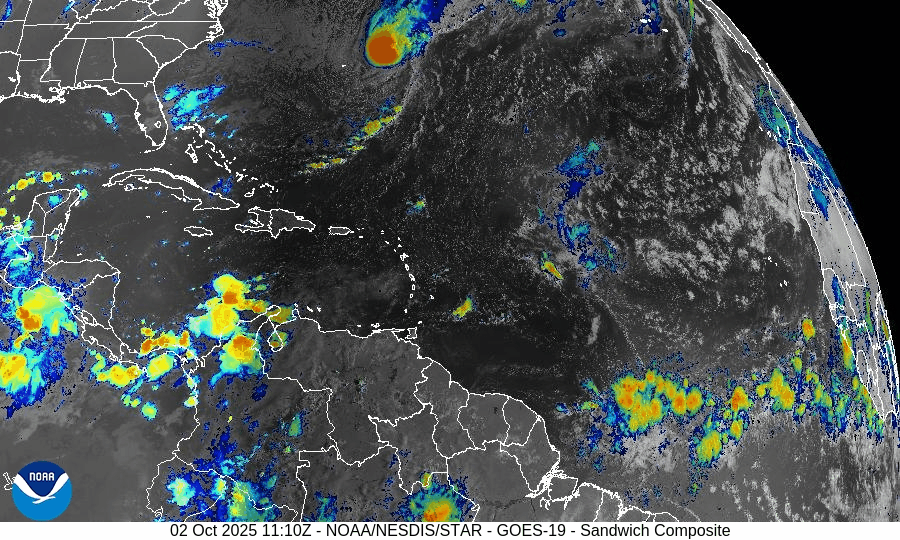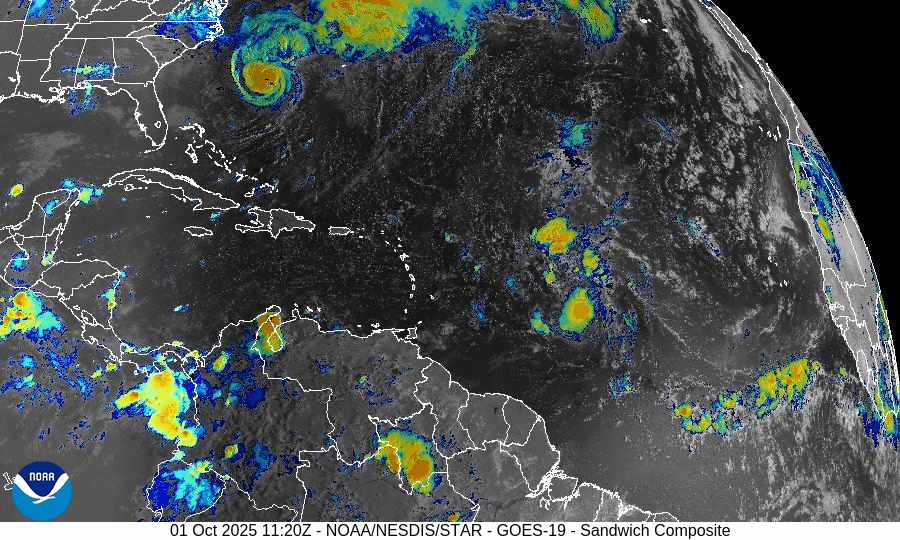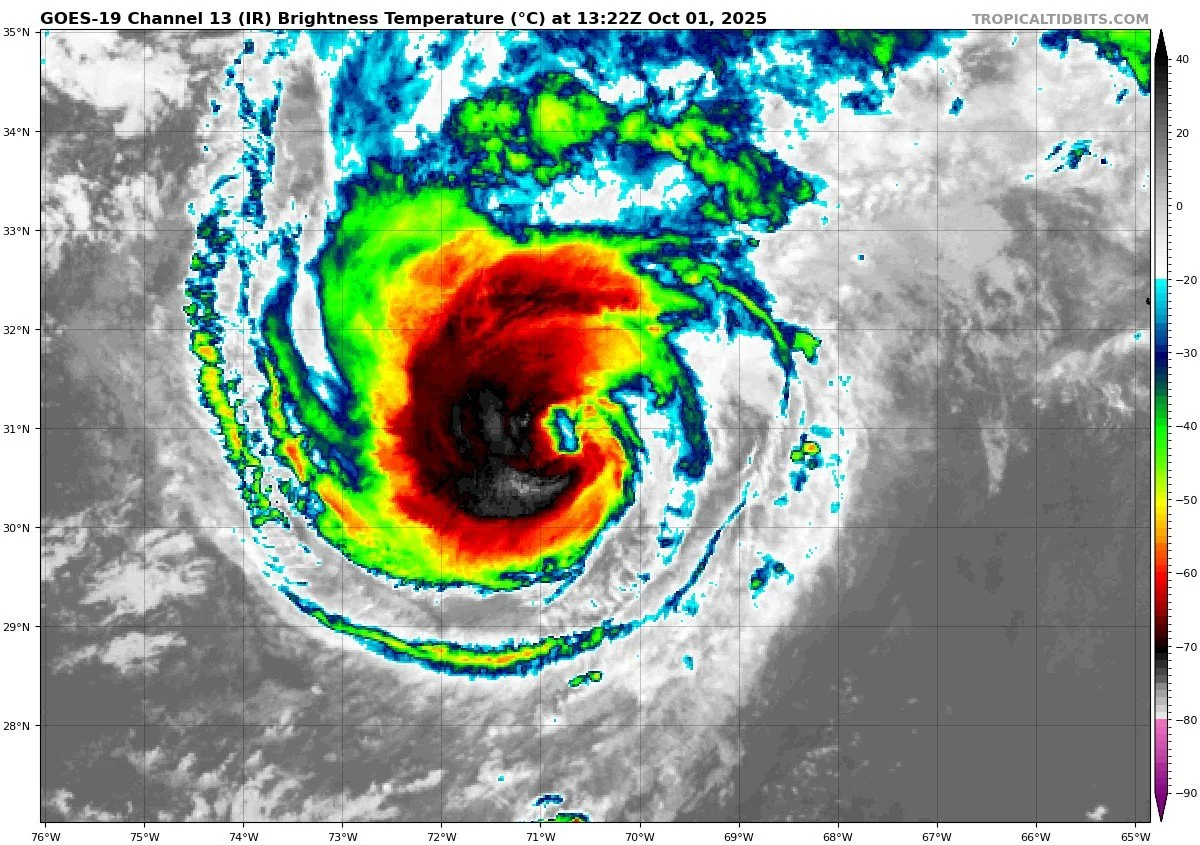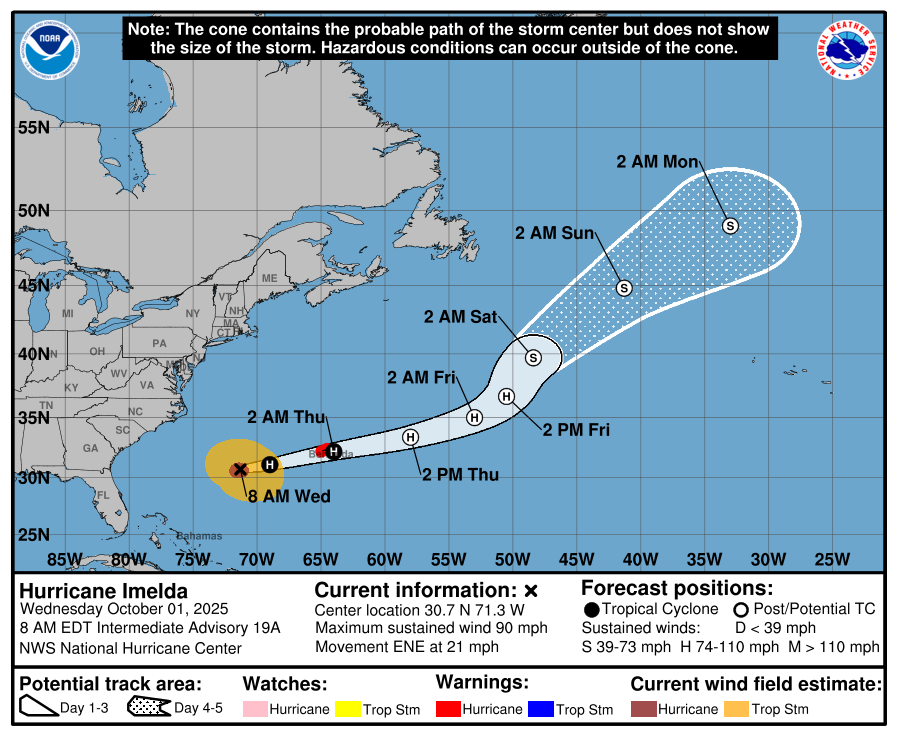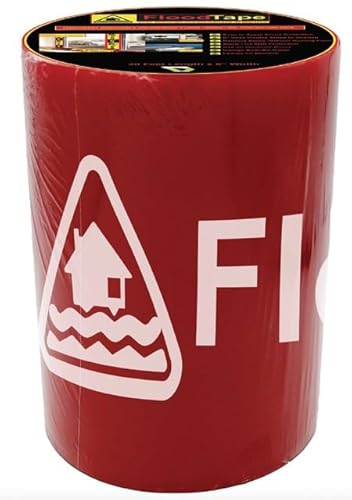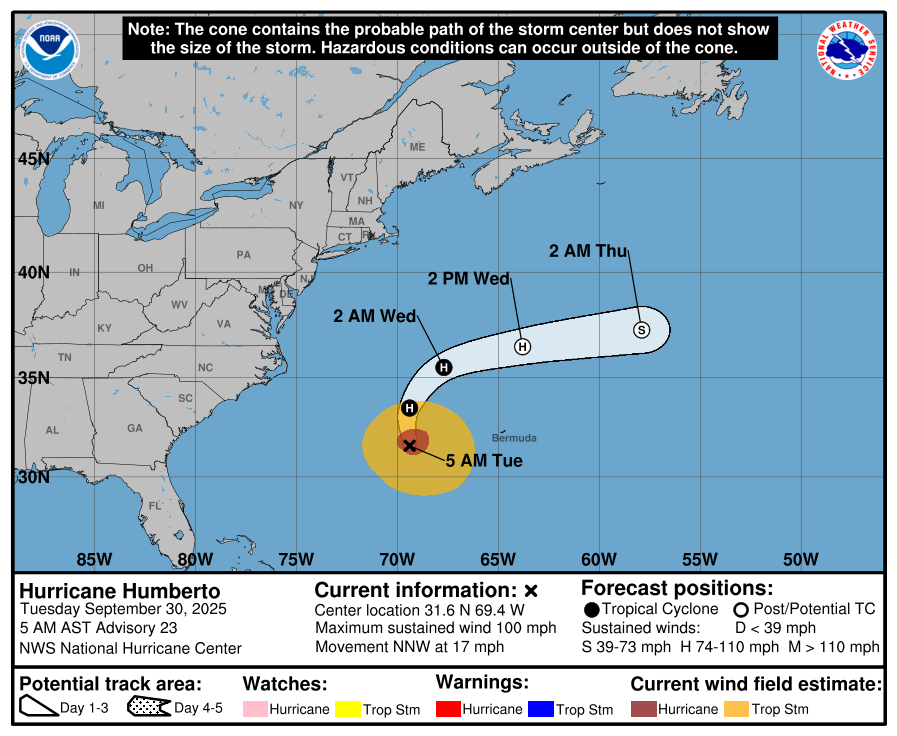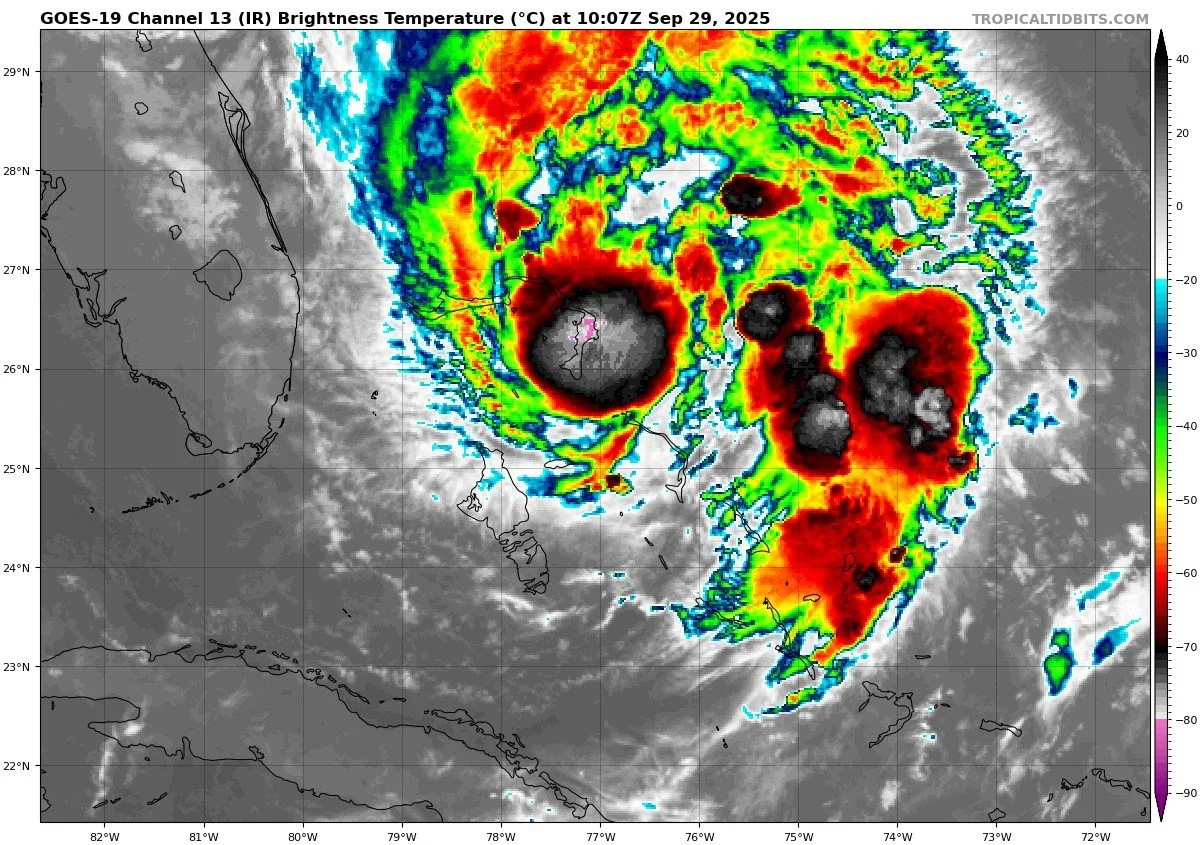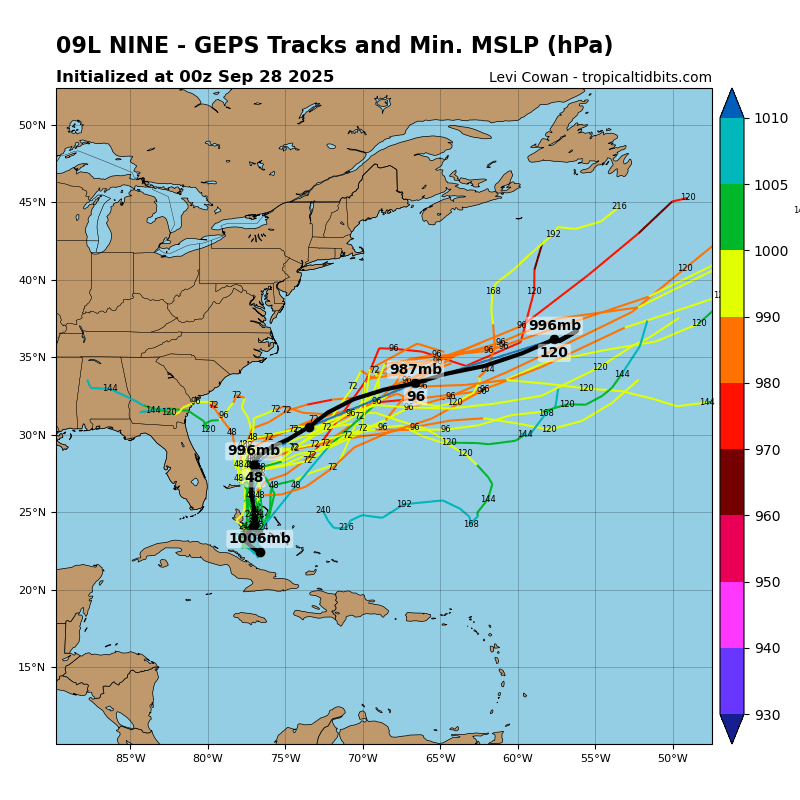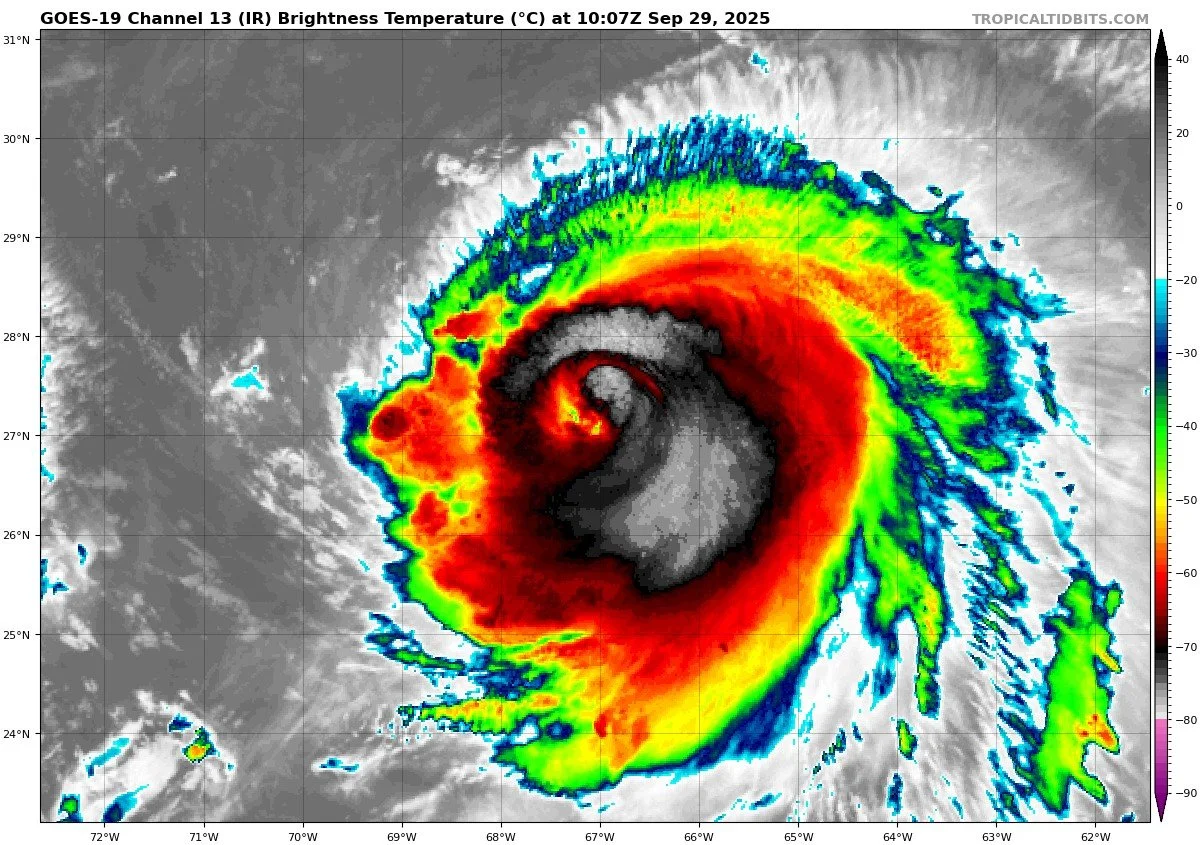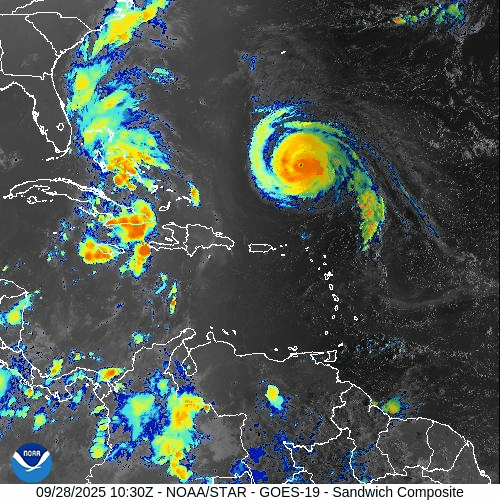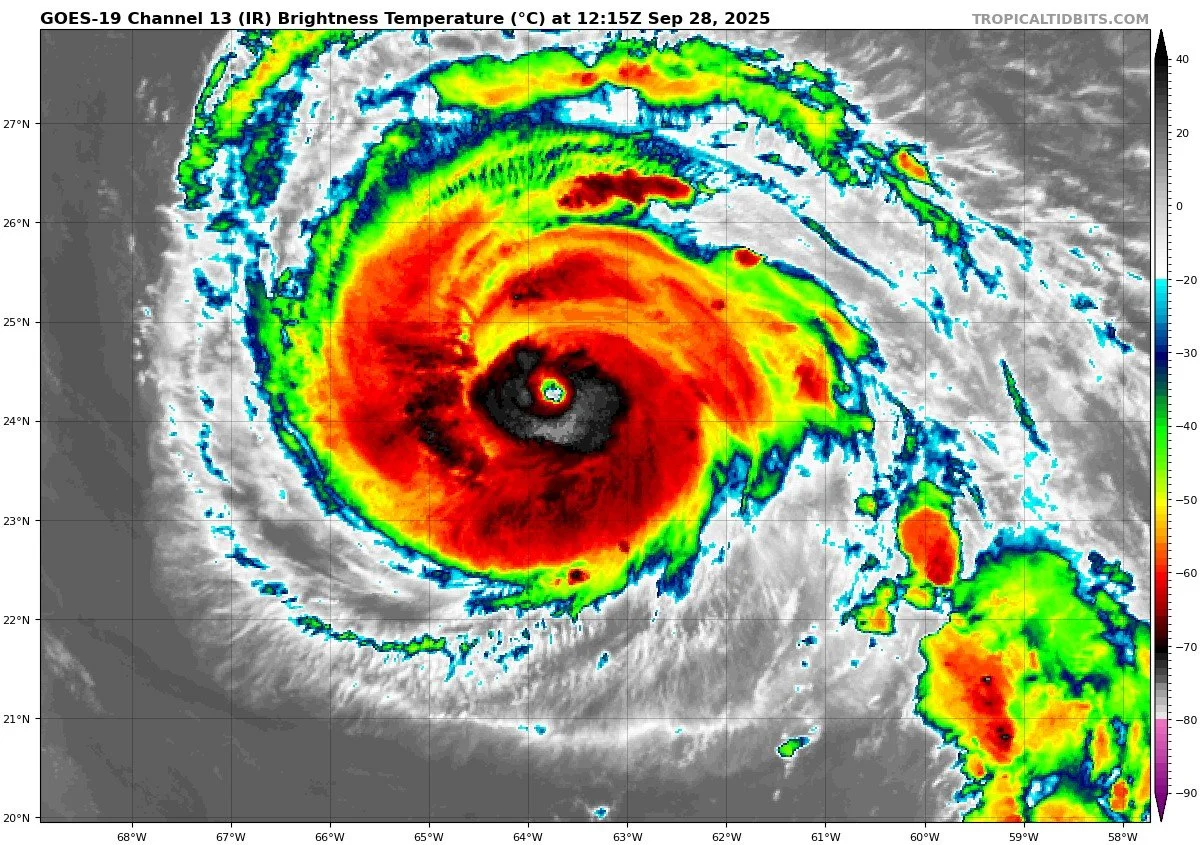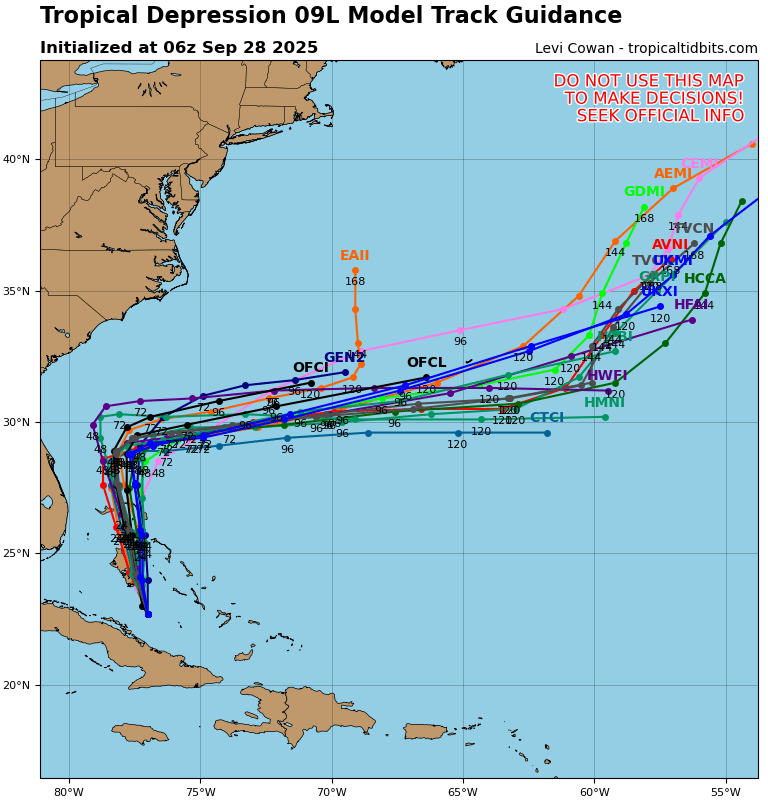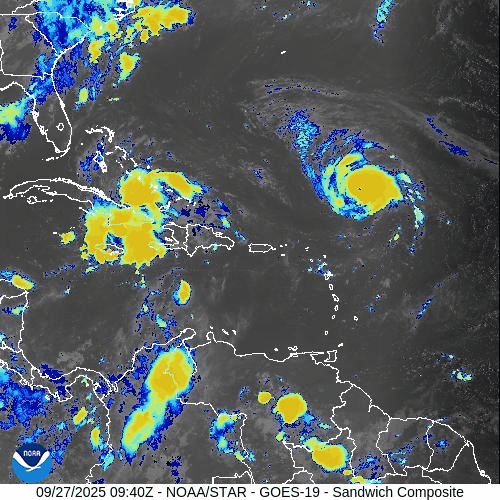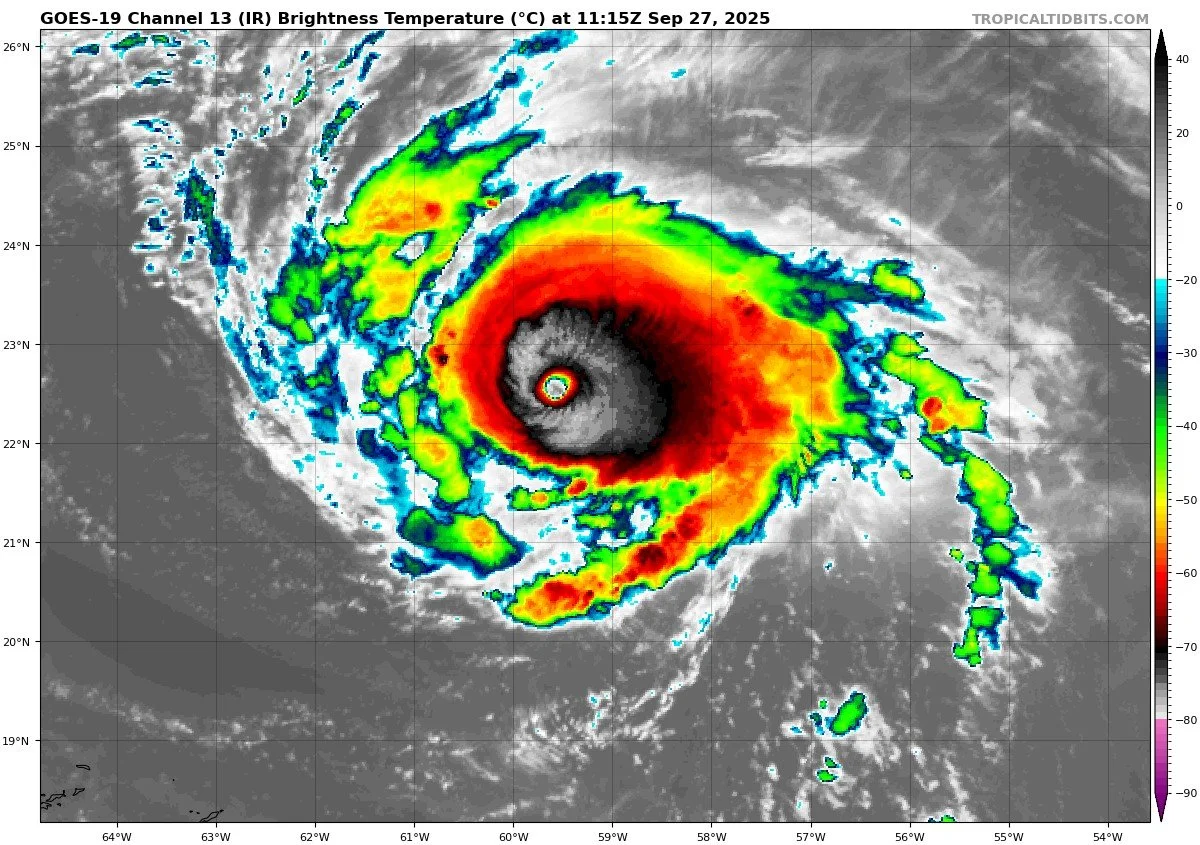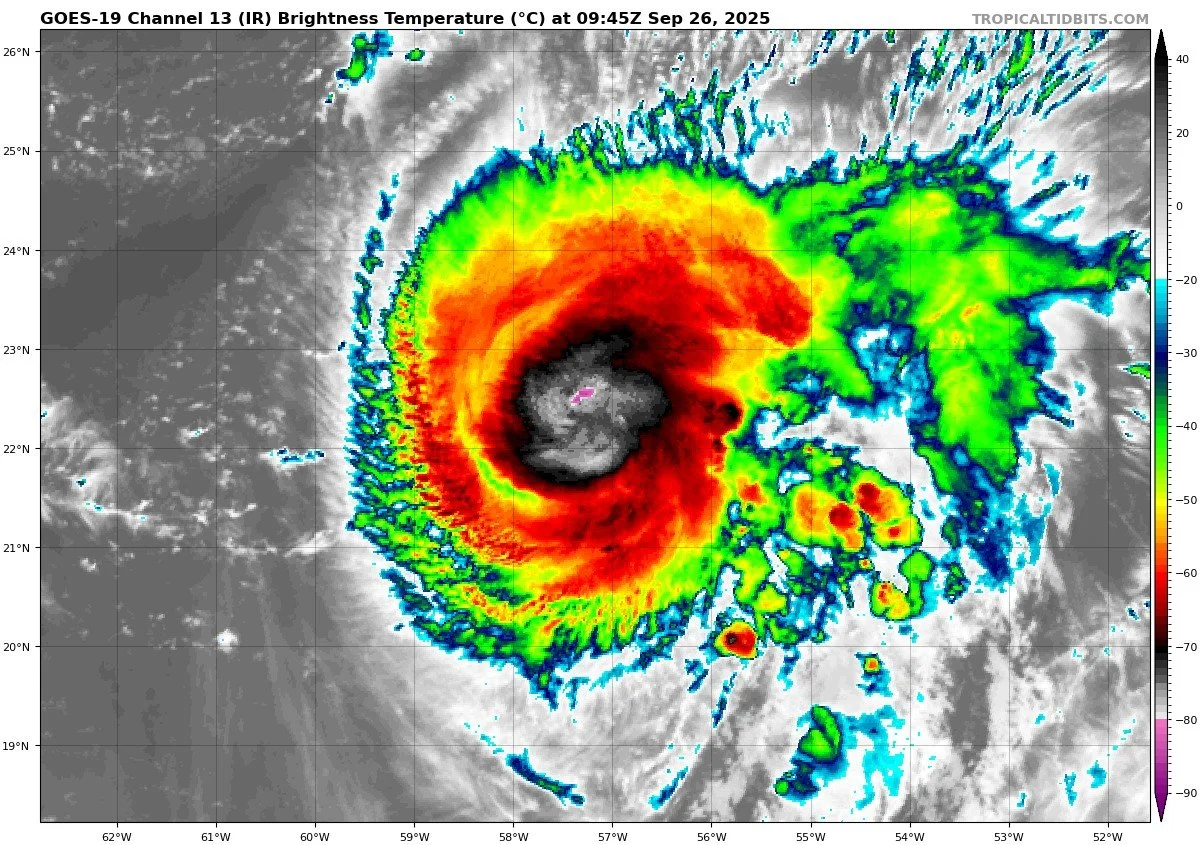Atlantic Hurricane Outlook – October 16, 2025
On October 16, Tropical Storm Lorenzo continues to weaken while tracking northeast over the central Atlantic with winds around 40 mph. Increasing wind shear, cooler waters, and dry air are causing the system to lose strength. No other tropical development is expected across the basin, and Florida and the Gulf of America remain quiet aside from minor marine swells and rip current risks.
Tropical Storm Lorenzo continues weakening over open waters; no new systems developing
Atlantic Basin Overview
Tropical Storm Lorenzo
Lorenzo is weakening while maintaining a general north to northeast track over the central Atlantic. Lorenzo has maximum sustained winds of about 40 mph, with tropical-storm-force winds extending outward roughly 60 miles from the center.
Lorenzo will shift toward the northeast later in the week and gradually dissipate, with no landfall expected.Other Tropical Activity
There are currently no other active tropical cyclones in the Atlantic, Caribbean, or Gulf basins. The NHC’s 7-day outlook indicates no additional tropical cyclone formation expected in that timeframe.
Environmental Conditions
Sea Surface Temperatures (SSTs):
Lorenzo is traversing moderately warm waters supportive of tropical structure, though as it moves northward it will encounter cooler SSTs that accelerate decay.Wind Shear:
The system continues to face moderate to strong vertical wind shear, which is limiting deep convection and contributing to its weakening trend.Dry Air / SAL (Saharan Air Layer):
Surrounding dry air and intrusions of dust remain factors, suppressing convection in outer bands and preventing reintensification.
Gulf of America & Caribbean
As of now, the Gulf of America and Caribbean remain quiet, with no organized tropical systems developing. Routine seasonal convection (showers, storms) continues.
Florida & Eastern U.S. Forecast
No tropical threats are forecast for Florida or the U.S. East Coast, as Lorenzo stays well offshore. The main impact to watch is marine hazards: lingering swells, rough surf, and rip currents along Atlantic beaches may continue through the period.
Rain forecast visualization courtesy of Windy.com
TL;DR – October 16 Snapshot
Lorenzo has weakened to ~40 mph and is heading northeast over open water.
No new tropical systems are being tracked.
Environmental conditions—shear, cooler SSTs, dry air—are eroding Lorenzo’s structure.
Gulf, Caribbean, Florida remain calm.
Coastal marine hazards remain the primary concern.
Atlantic Hurricane Outlook – October 14, 2025
On October 14, Tropical Storm Lorenzo remains active in the central Atlantic, moving northwest with sustained winds of 60 mph. The storm is expected to turn north and then northeast, staying over open water as it contends with moderate wind shear and dry air. No other tropical systems are active, and the Gulf of America and Florida remain calm aside from routine marine swells.
Tropical Storm Lorenzo active over open waters; no land threats identified
Atlantic Basin Overview
Tropical Storm Lorenzo
As of the 5:00 AM AST advisory, Lorenzo is centered near 17.3° N, 44.1° W, roughly 1,330 miles west of the Cabo Verde Islands.
Lorenzo is moving northwest at about 15 mph (13 kt).
Maximum sustained winds are near 60 mph (50 kt), with tropical-storm-force winds extending outward up to 175 miles (280 km) from the center.
The minimum central pressure is about 1000 mb.
The forecast track calls for Lorenzo to continue northwestward today, followed by a turn north tonight, then northeast by Wednesday–Thursday.
Little change in strength is expected over the next several days.Other Systems / Disturbances
No other tropical cyclones are active in the Atlantic or Caribbean at present.
The 7-day outlook shows no additional tropical cyclone development expected in that period.
Environmental Conditions
Sea Surface Temperatures (SSTs):
SSTs along Lorenzo’s projected track remain sufficiently warm to support continued tropical storm strength.Wind Shear:
Lorenzo is contending with moderate wind shear, which is contributing to a somewhat disorganized structure.Dry Air / Saharan Air Layer (SAL):
Dry air and Saharan dust are present in surrounding areas, which may suppress convective expansion, especially in outer bands.
Gulf of America & Caribbean
These regions remain quiet, with no organized tropical systems. The typical October pattern of scattered showers and thunderstorms continues.
Florida & Eastern U.S. Forecast
No tropical threat to Florida or the U.S. East Coast is foreseen. Lorenzo is expected to remain over open ocean, turning away from land.
Marine concerns—swells, surf, and rip currents—may extend across portions of the Atlantic as Lorenzo propagates energy westward, but no direct impacts are anticipated for coastal U.S. areas.
TL;DR – October 14 Snapshot
Lorenzo is active in the central Atlantic with 60 mph winds.
Steering pattern to turn it north, then northeast; no land threat.
Environmental conditions limit strong intensification.
Gulf and Caribbean quiet.
Florida & U.S. East Coast: no tropical impacts expected.
Atlantic Hurricane Outlook – October 13, 2025
On October 13, Tropical Storm Lorenzo formed in the central Atlantic with maximum winds near 45 mph and favorable conditions for further development. The system is expected to strengthen steadily as it moves west-northwest over warm 29–30°C waters. Meanwhile, post-tropical Jerry continues east of Bermuda, and Florida remains clear of tropical threats aside from elevated surf along the Atlantic coast.
Tropical Storm Lorenzo forms in the central Atlantic; Jerry now post-tropical east of Bermuda
Atlantic Basin Overview
Tropical Storm Lorenzo (formerly Invest 97L)
The National Hurricane Center has officially designated Tropical Storm Lorenzo (AL17) in the central tropical Atlantic, located near 12°N, 38°W, or roughly 900 miles southwest of the Cabo Verde Islands.
Lorenzo is moving west-northwest at around 15 mph, with maximum sustained winds near 45 mph and minimum central pressure near 1005 mb.Organization has improved significantly over the past 24 hours, with persistent convection consolidating around a developing center. The storm’s cloud structure shows banding features and outflow beginning to improve on its western flank.
Forecast & Track:
Lorenzo is expected to continue moving west-northwest for the next several days, gradually turning more northwest by midweek under the influence of a mid-level ridge.
Environmental conditions—warm sea surface temperatures (29–30°C), ample mid-level moisture, and low vertical wind shear (10–15 kt)—favor steady strengthening, and Lorenzo could become a hurricane by Wednesday or Thursday if current trends continue.Model guidance (ECMWF, GFS, and HWRF ensembles) indicates Lorenzo will likely remain over open waters through the week, though some long-range uncertainty remains regarding a possible westward bend late in the period.
Post-Tropical Jerry (east of Bermuda)
The remnants of Tropical Storm Jerry are now an elongated trough east-southeast of Bermuda. Gale-force winds (35–40 kt) persist along the northern edge, but the system lacks tropical characteristics and is not expected to redevelop. Seas near the trough remain 10–14 feet, gradually subsiding through Tuesday.Subtropical Storm Karen (north Atlantic)
Karen continues to weaken over the far North Atlantic, with maximum winds near 40 mph. The system is expected to lose its subtropical structure and dissipate within 24 hours over cold waters.
Environmental Conditions
Sea Surface Temperatures (SSTs):
SSTs across Lorenzo’s path remain well above average (29–30°C) — highly favorable for sustained deep convection and intensification.Wind Shear:
Current shear is low to moderate (10–15 kt) in the central Atlantic, allowing Lorenzo to organize further. Slight increases in shear may occur later this week as the storm tracks northwest.Humidity & Dry Air / SAL:
The Saharan Air Layer remains present north and east of Lorenzo but has receded sufficiently to the northeast. Moisture surrounding the storm’s core is increasing, limiting dry air intrusion and supporting vertical growth.
Gulf of America & Caribbean
The Gulf of America and Caribbean remain quiet. No tropical development is expected in these regions through at least the next 5–7 days. Afternoon convection and sea-breeze thunderstorms continue as typical for October.
Florida & Eastern U.S. Forecast
There are no immediate tropical threats to Florida or the U.S. East Coast. Lorenzo is far out in the central Atlantic, and current steering patterns favor a northwest track away from land.
Residual swell energy from past systems, combined with seasonal transitions, will continue to produce high surf and rip current risks along the Southeast and Mid-Atlantic beaches.
Otherwise, Florida remains under typical early-fall conditions—warm, humid afternoons with isolated sea-breeze storms.
Rain forecast visualization courtesy of Windy.com
TL;DR – October 13 Snapshot
Tropical Storm Lorenzo (AL17) has officially formed in the central Atlantic, moving WNW with 45 mph winds.
Favorable conditions (warm SSTs, low shear, and increasing moisture) support strengthening—could reach hurricane strength midweek.
Post-tropical Jerry continues east of Bermuda with lingering gales.
Karen dissipating in the North Atlantic.
No tropical threats to Florida or the U.S. mainland at this time.
Marine impacts (swells, rip currents) remain the primary concern along Atlantic beaches.
Atlantic Hurricane Outlook – October 10, 2025
On October 10, Tropical Storm Jerry is weakening as it turns northward in the Atlantic, while a developing Nor’easter off the U.S. East Coast brings flooding rains, high surf, and coastal winds to the Mid-Atlantic and New England. Subtropical Storm Karen continues to fade over the northern Atlantic, and no new tropical systems are expected. Florida and the Gulf of America remain calm aside from elevated surf.
Tropical Storm Jerry weakens; Subtropical Storm Karen fading; Nor’easter developing off the U.S. East Coast
Atlantic Basin Overview
Tropical Storm Jerry
Jerry is located about 80 miles north-northeast of the Northern Leeward Islands, moving northwest at ~17 mph, with maximum sustained winds of 50 mph. Tropical-storm-force winds extend outward nearly 185 miles to the east of center.
Jerry continues to battle moderate to strong wind shear and dry mid-level air, keeping its convection displaced from the low-level center. Gradual weakening is expected as it curves north, and Jerry could lose tropical characteristics by Saturday, becoming post-tropical as it interacts with an upper trough.Subtropical Storm Karen
Karen, in the far North Atlantic, is weakening over cooler waters and increasing shear. It will transition to a post-tropical low within 24 hours and pose no threat to land.Non-Tropical Coastal Storm / Nor’easter (Western Atlantic)
A strengthening non-tropical low has formed just off the Mid-Atlantic and Northeast U.S. coastline, drawing deep Atlantic moisture into the region.
This hybrid system—not yet tropical but highly impactful—is producing:
• Heavy rain and coastal flooding from New Jersey through New England
• Gale- to storm-force winds along the coast and offshore waters
• Dangerous surf, rip currents, and beach erosion extending through the weekend
The system will likely intensify further as it moves north-northeast, behaving more like a Nor’easter than a tropical cyclone. While not classified as tropical, its impacts on populated areas are as significant as a weak hurricane, and it should be treated with equal caution by coastal interests.
Environmental Conditions
Sea Surface Temperatures (SSTs):
Warm (28–29 °C) near Jerry’s current location, but cooling rapidly northward. The Nor’easter’s energy source is baroclinic (temperature-gradient driven) rather than tropical heat.Wind Shear:
Strong upper-level winds dominate the western Atlantic—one reason Jerry is weakening and why the Nor’easter is deepening outside the tropics.Humidity & Dry Air / SAL:
Dry Saharan air continues to limit convection around Jerry’s western flank; mid-latitude dry slots are also influencing the Nor’easter’s structure.
Gulf of America & Caribbean
The Gulf of America and Caribbean remain calm, with no organized tropical activity. Conditions are dominated by localized thunderstorms and standard early-October convection.
Florida & Eastern U.S. Forecast
Florida: No tropical threats. Expect humid, stormy afternoons and increased rip current risk from Atlantic swells.
Eastern Seaboard (Mid-Atlantic to New England): Impacts are already underway from the non-tropical coastal storm / Nor’easter—including gusty winds, heavy rain, and flooding tides. Residents should monitor local advisories and coastal flood warnings.
Rain forecast visualization courtesy of Windy.com
TL;DR – October 10 Snapshot
Jerry: 50 mph tropical storm curving north, expected to weaken and turn post-tropical soon.
Karen: Subtropical storm weakening over the North Atlantic.
Nor’easter: Powerful non-tropical coastal storm developing off the Eastern U.S.—causing flooding, wind, and surf hazards through the weekend.
Gulf & Caribbean: Quiet.
Florida: No direct threats but increased surf.
Atlantic Hurricane Outlook – October 9, 2025
On October 9, Tropical Storm Jerry continues to strengthen in the central Atlantic with sustained winds near 65 mph. The storm is forecast to become a hurricane within 24–48 hours as it tracks west-northwest toward the northern Leeward Islands. Meanwhile, a disturbance in the Bay of Campeche carries only a 10% development chance. Florida and the Gulf of America remain calm aside from elevated surf and rip currents.
Tropical Storm Jerry continues west-northwest; likely intensification ahead; Gulf disturbance still low probability
Atlantic Basin Overview
Tropical Storm Jerry
Jerry remains active in the Atlantic, located about 355 miles east-southeast of the northern Leeward Islands, moving west-northwest at ~20 mph, with sustained winds near 65 mph.
The system is expected to strengthen into a hurricane by Friday or Saturday, as conditions favor further intensification.
A tropical storm watch is in effect for islands such as Antigua, Barbuda, and St. Kitts as Jerry approaches.Gulf / Bay of Campeche Disturbance
A broad area of showers and thunderstorms continues in the Bay of Campeche with only a 10% chance of development per current outlooks over the next 48 hours and 7 days.
Environmental Conditions
Sea Surface Temperatures (SSTs):
SSTs ahead of Jerry remain warm enough to support further strengthening into a hurricane, particularly over the central Atlantic.Wind Shear:
Moderate wind shear is present and may temper the rate of intensification, but not enough to prevent Jerry from likely becoming a hurricane under favorable alignment.Humidity & Dry Air / SAL (Saharan Air Layer):
Dry air and Saharan dust remain in portions of the eastern Atlantic, and these factors may limit convective expansion on Jerry’s flanks. The core appears better insulated from these effects currently.
Gulf of America & Caribbean
These regions remain relatively quiet. The Bay of Campeche disturbance is not expected to develop substantially, and no other tropical systems are showing strong signs of formation.
Florida & Eastern U.S. Forecast
Florida and the broader Eastern U.S. remain outside the immediate threat zone of Jerry. However:
Coastal and marine areas should remain alert for increasing surf, rip currents, and ocean swells as Jerry intensifies.
If Jerry curves northward later, Eastern U.S. coasts—especially the islands and the Leeward chain—could face tropical storm forces and heavy rain.
Inland Florida continues typical early-October weather: humidity, scattered storms, and localized downpours.
Rain forecast visualization courtesy of Windy.com
TL;DR – October 9 Snapshot
Jerry is intensifying, moving WNW, with top winds ~65 mph and is expected to become a hurricane soon.
The Bay of Campeche disturbance remains weak, with only 10% development odds.
SSTs support intensification; moderate shear and dry air may limit strength on the periphery.
Gulf of America and Caribbean remain calm.
Florida and U.S. East Coast currently face no direct land threat, but marine impacts are ongoing and may increase.
Atlantic Hurricane Outlook – October 8, 2025
On October 8, Tropical Storm Jerry has formed from Invest 95L in the central Atlantic and continues to strengthen on its west-northwest path toward the Leeward Islands. The National Hurricane Center has also noted a weak disturbance in the Bay of Campeche with only a 10% chance of development. Jerry remains no threat to Florida or the U.S. mainland, though dangerous surf and rip currents may develop along the East Coast as the storm intensifies.
Tropical Storm Jerry strengthens; Gulf disturbance has low odds of development
Atlantic Basin Overview
Tropical Storm Jerry
The disturbance Invest 95L has now officially become Tropical Storm Jerry, located several hundred miles east-southeast of the northern Leeward Islands. Jerry continues its west-northwest track, and a tropical storm watch has been issued for parts of the northern Leeward Islands as the system is forecast to strengthen further.Gulf / Bay of Campeche Disturbance
A broad area of disorganized showers and thunderstorms persists over the Bay of Campeche. Some slow development is possible before the system moves inland over southern Mexico. However, the NHC currently assigns it only about a 10% chance of development over both the next 48 hours and 7 days.
Environmental Conditions
Sea Surface Temperatures (SSTs):
SSTs ahead of Jerry remain warm enough (around 28–29 °C) to support continued intensification.Wind Shear:
Jerry is in a region of moderate shear which may slow rapid strengthening. If it can consolidate its core, further intensification is possible.Humidity & Dry Air / SAL (Saharan Air Layer):
Dry air and dust from the Saharan Air Layer are present across parts of the eastern Atlantic, which could limit convective coverage in Jerry’s outer bands.
Gulf of America & Caribbean
The Gulf of America and Caribbean remain quiet. No organized tropical development is expected there at present, outside the low-chance Bay of Campeche disturbance.
Florida & Eastern U.S. Forecast
Florida and the U.S. East Coast are not currently under direct threat from Jerry. The storm is still far east, and its path is expected to curve north later. Coastal areas should continue to monitor swells, surf, and rip currents as Jerry intensifies and pushes ocean energy westward.
Rain forecast visualization courtesy of Windy.com
TL;DR – October 8 Snapshot
Jerry is now a tropical storm, moving WNW toward the Leeward Islands with strengthening likely.
Bay of Campeche disturbance has low development chance (~10%).
Warm SSTs favor Jerry; shear and dry air could limit growth.
Gulf and Caribbean quiet otherwise.
Florida/Eastern U.S.: no land threat, but marine impacts (surf/rip currents) remain.
Atlantic Hurricane Outlook – October 7, 2025
On October 7, Invest 95L continues to consolidate in the central Atlantic, now with a 90% chance of development according to the National Hurricane Center. The disturbance is likely to become a tropical depression or named storm within 24–48 hours as it moves west-northwest through warm 29–30°C waters. No immediate land threats are expected, and Florida and the Gulf of America remain calm.
Invest 95L shows rapid organization; 90% chance of tropical development in the central Atlantic
Atlantic Basin Overview
Invest 95L (High Chance of Development)
The National Hurricane Center has increased development odds for Invest 95L to 90% over the next 7 days, as satellite imagery shows rapidly improving organization in the central tropical Atlantic, about halfway between the Cabo Verde Islands and the Lesser Antilles.The disturbance continues to consolidate with:
• Expanding convection around a developing low-level center.
• Stronger curvature in cloud bands.
• Favorable oceanic and atmospheric support for intensification.If current trends persist, this system will likely become a tropical depression within 24–48 hours, and could be named Tropical Storm Jerry soon after.
Model guidance continues to favor a west-northwest track through midweek, gradually turning more northwest by the weekend as it encounters subtropical steering.No immediate land threats are expected, though long-range trends will be monitored closely for potential shifts toward the western Atlantic later this week.
Other Atlantic Activity
No additional organized systems are currently being monitored.
Environmental Conditions
Sea Surface Temperatures (SSTs):
SSTs in the central Atlantic remain very warm (29–30 °C) — more than sufficient to support strengthening if the disturbance maintains convection.Wind Shear:
The system is positioned in a region of low to moderate vertical wind shear (10–15 kt), favorable for gradual intensification over the next few days. Shear may increase slightly later in the week as the system moves northwest.Humidity & Dry Air / SAL:
Moisture levels have improved, and the surrounding Saharan Air Layer (SAL) has thinned significantly, creating a more favorable pocket for development. Only minor dry air entrainment remains on the northern flank of the disturbance.
Gulf of America & Caribbean
The Gulf of America and Caribbean remain calm with no tropical development expected. Conditions are dominated by seasonal convection and scattered thunderstorms typical for early October.
Florida & Eastern U.S. Forecast
There are no immediate tropical threats to Florida or the U.S. East Coast.
The developing system is far east in the Atlantic, thousands of miles away. Even with potential intensification, model guidance currently suggests a turn away from the U.S. mainland later this week.
Coastal conditions: Residual swells and rip currents continue along Atlantic beaches from previous systems and may increase slightly if 95L strengthens further.
Rain forecast visualization courtesy of Windy.com
TL;DR – October 7 Snapshot
Invest 95L in the central Atlantic now carries a 90% chance of development.
Likely to become a tropical depression or named storm (Jerry) within 24–48 hours.
Favorable conditions: warm SSTs, light shear, improving humidity.
No immediate threat to Florida, the Caribbean, or the U.S. mainland.
Gulf of America remains quiet with no tropical formation expected.
Main hazards remain limited to marine impacts (rip currents, swell).
Atlantic Hurricane Outlook – October 6, 2025
On October 6, a tropical disturbance in the central Atlantic maintains a 70% chance of development according to the National Hurricane Center. The system remains disorganized but is moving through warm waters conducive to gradual formation. Environmental factors like dry air and moderate wind shear are slowing intensification. Florida and the Gulf of America remain free of direct tropical threats.
No active tropical systems; a disturbance in the central Atlantic bears watching
Atlantic Basin Overview
No Active Tropical Cyclones
Currently there are no named storms or hurricanes in the Atlantic, Caribbean, or Gulf of America per the latest NHC outlook.Disturbance Under Monitoring
The NHC continues to track a tropical wave / disturbance in the central Atlantic with increasing organization and favorable parameters. This system retains a 70% chance of tropical development over the next 7 days as earlier reported.
Environmental Conditions
Sea Surface Temperatures (SSTs):
SSTs across much of the tropical Atlantic and the disturbance’s projected path remain warm, generally supportive for development if other conditions align.Wind Shear:
Elevated vertical wind shear remains a limiting factor across broad parts of the Atlantic. That shear may slow intensification or disrupt organization of the monitored disturbance.Humidity & Dry Air / SAL:
Mid-level dry air and Saharan dust intrusions persist in portions of the basin. Those dry air inclusions and SAL effects continue to suppress convective vigor in developing systems, especially farther east.
Gulf of America & Caribbean
The Gulf of America and Caribbean basins remain quiet. No tropical systems are forming at present; convection is limited to normal seasonal showers and thunderstorms.
Florida & Eastern U.S. Forecast
Florida and the Eastern U.S. are currently not under direct tropical threat. The disturbance is positioned well east of the region. The main concern along the Atlantic coast continues to be elevated surf, swells, and rip current risk, especially if the disturbance develops and enhances ocean motion.
Rain forecast visualization courtesy of Windy.com
TL;DR – October 6 Snapshot
No active storms at the moment.
A central Atlantic disturbance holds a 70% 7-day development chance.
SSTs are favorable; shear and dry air are still challenges.
Gulf of America and Caribbean are quiet.
Florida/Eastern U.S.: no direct threat; marine conditions (surf/rip currents) remain the main hazard.
Atlantic Hurricane Outlook – October 5, 2025
On October 5, a tropical disturbance in the central Atlantic is showing improved organization and now carries a 70% chance of development according to the National Hurricane Center. The system may become a tropical depression or storm early this week as it moves west-northwest across warm waters. Imelda’s remnants continue to fade, and the Gulf of America and Florida remain quiet aside from minor marine impacts.
Tropical disturbance in central Atlantic gains strength; 70% development chance in coming days
Atlantic Basin Overview
Invest Area – Central Atlantic Disturbance (High Chance of Formation)
The National Hurricane Center is closely monitoring a well-defined tropical wave located in the central tropical Atlantic, roughly halfway between the Cabo Verde Islands and the Lesser Antilles.The system has shown improving organization over the past 24 hours with:
• Persistent clusters of deep convection.
• Increasing low-level rotation visible in satellite imagery.
• A pocket of lighter wind shear and higher mid-level humidity supporting development.The NHC now gives this system a 70% chance of tropical cyclone formation within 7 days, and it may become a tropical depression or storm early this week as it moves west-northwest at 10–15 mph across warm 29–30 °C waters.
Long-range model guidance suggests the system will stay well east of the Caribbean for the next 5 days, though trends bear monitoring.
Post-Tropical Imelda
Imelda remains a strong post-tropical cyclone over the open Atlantic. It is racing east-northeast and poses no threat to land, though it continues to generate residual swell and rough seas over parts of the North Atlantic.Other Waves / Disturbances
No additional organized systems are present. A weak wave emerging from western Africa remains broad and disorganized under dry air.
Environmental Conditions
Sea Surface Temperatures (SSTs):
SSTs across the central and western tropical Atlantic remain above average (29–30 °C), easily supportive of development if convection persists.Wind Shear:
The disturbance lies in a localized pocket of lower shear (10–15 kt), which is helping convection consolidate. Stronger shear farther west may slow development later in the week.Humidity & Dry Air / SAL:
The Saharan Air Layer (SAL) continues to influence the eastern Atlantic but has weakened around the current disturbance. Improved mid-level moisture is aiding its gradual organization.
Gulf of America & Caribbean
The Gulf of America and Caribbean remain calm with no tropical systems expected. Daily thunderstorms continue in typical early-October fashion.
Florida & Eastern U.S. Forecast
There are no immediate tropical threats to Florida or the Eastern U.S. at this time.
The ongoing Atlantic disturbance is far east of the region and poses no short-term risk. Coastal conditions remain influenced by lingering swell energy from Imelda, producing rough surf and rip currents along Atlantic beaches.
Rain forecast visualization courtesy of Windy.com
TL;DR – October 5 Snapshot
A tropical disturbance in the central Atlantic has a 70% chance of development over the next 7 days.
The system is expected to move west-northwest, staying well east of the Caribbean in the short term.
Imelda remains post-tropical and no longer a threat.
Environmental factors — warm SSTs, low shear, and improved moisture — favor gradual development.
Florida and the Gulf of America remain quiet, with marine impacts limited to elevated surf and rip currents.
Atlantic Hurricane Outlook – October 3, 2025
On October 3, Imelda has transitioned into a post-tropical cyclone while racing east-northeast after impacting Bermuda. While no longer tropical, Imelda continues to drive dangerous swells and rip currents along the U.S. East Coast. Humberto has dissipated, and other Atlantic disturbances remain suppressed by dry air and wind shear. Florida and the Gulf of America remain free of direct tropical threats.
Imelda now post-tropical, swells and rip currents remain key concern for East Coast
Atlantic Basin Overview
Post-Tropical Imelda
Imelda has transitioned to a post-tropical cyclone after passing near Bermuda. While it no longer maintains full tropical structure, it continues to generate strong winds, rain, and ocean swell. Impacts are now mostly marine and coastal in nature rather than landfall risks.Humberto & Other Waves
Humberto has lost tropical characteristics and merged with mid-latitude systems, but its residual energy still contributes to elevated surf and rip current conditions along the U.S. East Coast. Other Atlantic disturbances remain weak and suppressed by environmental constraints.
Environmental Conditions
Sea Surface Temperatures (SSTs):
SSTs beneath Imelda’s path remain moderately warm, but cooler waters ahead are aiding its weakening and limiting further tropical regeneration.Wind Shear:
Increasing vertical wind shear is disrupting Imelda’s convection and hastening its transition away from tropical structure.Humidity & Dry Air / SAL:
Dry mid-level air and Saharan dust continue to intrude, especially around weaker disturbances, suppressing convective activity and impeding new development.
Gulf of America & Caribbean
The Gulf of America and Caribbean remain calm with no organized tropical systems. Only typical late-season convection (afternoon storms) is present.
Florida & Eastern U.S. Forecast
Florida will remain outside the core of Imelda, though elevated surf, swell, and rip current conditions persist along Atlantic beaches. The broader Eastern U.S. coast should continue to monitor marine impacts and occasional squalls driven by Imelda’s remnants.
Rain forecast visualization courtesy of Windy.com
TL;DR – October 3 Snapshot
Imelda is now post-tropical but still influencing coastal waters.
Humberto has transitioned to an extratropical system, but contributes to marine hazards.
Environmental factors (cooling waters, shear, dry air) continue to weaken Imelda and suppress new development.
Gulf and Caribbean remain quiet.
East Coast marine impacts (surf, rip currents) are the primary hazard now.
Atlantic Hurricane Outlook – October 2, 2025
On October 2, Hurricane Imelda has weakened to Category 1 while racing east-northeast away from Bermuda after bringing damaging winds and power outages to the island. Humberto has transitioned into an extratropical system, but swells and rip currents will persist along the U.S. East Coast. Environmental factors—cooler waters, rising wind shear, and Saharan dust—are driving Imelda’s decline and limiting new development. Florida and the Gulf of America remain quiet.
Imelda weaker but still impactful; Humberto dissipates; hazardous marine conditions persist
Atlantic Basin Overview
Hurricane Imelda
Imelda passed near Bermuda, causing widespread power outages, downed trees, and strong winds. It has since weakened to Category 1 status with sustained winds near 80 mph and is moving east-northeast at 30 mph. No U.S. landfall is expected as Imelda continues to track away.Hurricane Humberto
Humberto has merged with frontal systems and lost tropical characteristics, transitioning into an extratropical cyclone. Its circulation is no longer classified as a hurricane, though its remnant energy continues contributing to swells and marine hazards along the Atlantic.Other Disturbances / Waves
Additional Atlantic waves are being watched, but none currently show robust development or trajectories toward U.S. coasts under present forecasts.
Environmental Conditions
Sea Surface Temperatures (SSTs):
SSTs near Imelda and Bermuda remain warm enough to support tropical cyclone strength, but cooler waters lie ahead along its projected path, which will continue to weaken it.Wind Shear:
Vertical wind shear is increasing across Imelda’s circulation, eroding convection and weakening structural organization.Humidity & Dry Air / SAL:
Dry mid-level air and dust from the Saharan Air Layer are penetrating outer bands and suppressing convection, especially in weaker waves farther east. These factors continue to restrict new storm development.
Gulf of America & Caribbean
The Gulf of America and Caribbean remain quiet, with no organized tropical systems. Shower and thunderstorm activity is typical for early October, but no tropical threats are present.
Florida & Eastern U.S. Forecast
Florida and the Southeast U.S. are not expected to see a tropical landfall from Imelda. However, the East Coast continues to experience dangerous surf, strong rip currents, and elevated coastal flooding potential, driven by Imelda and Humberto’s residual swell energy.
Rain forecast visualization courtesy of Windy.com
TL;DR – October 2 Snapshot
Imelda is now a Category 1 hurricane, weakening as it moves away from Bermuda.
Humberto has lost its tropical nature and is now extratropical.
Warm SSTs support Imelda, but increasing shear and dry air accelerate weakening.
Gulf of America and Caribbean remain calm.
U.S. East Coast should continue monitoring marine conditions—surf and rip currents remain the main hazard.
Atlantic Hurricane Outlook – October 1, 2025
On October 1, Hurricane Imelda has strengthened to 90 mph as it accelerates toward Bermuda, where a hurricane warning is in effect. The storm is forecast to bring damaging winds, heavy rain, and coastal flooding to the island tonight. Meanwhile, Humberto remains offshore, producing hazardous surf and rip currents across the Atlantic. Environmental conditions—warmer SSTs but rising shear and Saharan dust—support Imelda’s current strength but will limit its future intensification. Florida and the Gulf of America remain calm.
Imelda attains hurricane strength en route to Bermuda; Humberto adds to oceanic hazards
Atlantic Basin Overview
Hurricane Imelda
As of 8:00 AM EDT, Imelda is located near 30.7°N, 71.3°W, about 395 miles west-southwest of Bermuda. It’s moving east-northeast at 21 mph with maximum sustained winds around 90 mph and a central pressure near 974 mb. A hurricane warning remains in effect for Bermuda. Imelda’s core is expected to pass near or over Bermuda tonight before heading away.Hurricane Humberto & Other Disturbances
Humberto remains active farther east in the Atlantic, contributing to dangerous marine conditions (swells, rip currents) that extend toward the U.S. East Coast. No new significant tropical developments are imminent per the latest outlooks.
Hurricane Imelda
Environmental Conditions
Sea Surface Temperatures (SSTs):
SSTs along Imelda’s projected track remain warm enough to support hurricane intensity as it approaches Bermuda, though cooler waters ahead will begin to weaken it over time.Wind Shear:
Moderate to increasing shear is expected, especially as Imelda accelerates east-northeast. This shear will work against further intensification and eventually strip its convection.Humidity & Dry Air / Saharan Air Layer (SAL):
Dry mid-level air and dust intrusions from the Saharan Air Layer continue to challenge Imelda’s outer circulation. These environmental suppressors reduce convective vigor, particularly in its outer bands. The combined influence of shear and dry air will limit how strong Imelda can become.
Gulf of America & Caribbean
The Gulf of America and Caribbean remain quiet with no organized tropical systems. Only typical late-summer convection (showers and thunderstorms) is present.
Florida & Eastern U.S. Forecast
Florida and the U.S. Eastern Seaboard are not expected to see a direct landfall from Imelda, as the storm is turning away. However, outer bands may brush parts of the Southeast with gusty showers and elevated surf. Dangerous surf and rip current conditions will continue along the Atlantic coastline as Imelda and Humberto generate swells offshore.
Rain forecast visualization courtesy of Windy.com
TL;DR – October 1 Snapshot
Imelda is now a hurricane, headed toward Bermuda, with damaging wind, rain, and surge risks for the island.
Humberto remains offshore, contributing to marine hazards.
Warm SSTs support Imelda’s intensity, but shear and dry air are working against it.
Gulf of America and Caribbean are calm and free of tropical threats.
Florida and the Eastern U.S. should monitor marine impacts and outer band impacts—no direct landfall forecast.
Atlantic Hurricane Outlook – September 30, 2025
On September 30, Tropical Storm Imelda is moving northeast offshore of the U.S. East Coast, with forecasts showing it could become a hurricane near Bermuda. While landfall in the U.S. is not expected, Imelda’s outer rainbands may bring gusty winds and showers to the Southeast. Swells from both Imelda and Hurricane Humberto will continue to generate dangerous surf and rip currents along Atlantic beaches. The Gulf of America and Caribbean remain quiet.
Imelda gaining strength; turns away from U.S. coast; Humberto remains offshore
Atlantic Basin Overview
Hurricane Imelda
As of 5:00 AM EDT today, Imelda was centered near 28.8° N, 76.8° W, about 165 mi north of Great Abaco Island and 755 mi WSW of Bermuda.
Imelda is moving northeast at 7 mph and is expected to increase forward speed and turn toward the east-northeast tonight.
Imelda is now a hurricane.Hurricane Humberto & Other Waves
Humberto remains a strong system over the Atlantic and continues to generate swells that affect the U.S. East Coast.
Other Atlantic waves are being monitored, but none show imminent organization or clear paths toward land.
Hurricane Imelda
Hurricane Humberto
Environmental Conditions
Sea Surface Temperatures (SSTs): SSTs in Imelda’s path remain favorable for strengthening; as Imelda moves northeast, it will eventually encounter cooler waters which may begin to inhibit further intensification.
Wind Shear: Moderate shear persists around Imelda, which could slow down its deepening. As it moves further northeast, shear is expected to increase, limiting structural organization.
Humidity & Dry Air / SAL: Dry mid-level air and Saharan dust continue to intrude over parts of the Atlantic, suppressing convection especially in outer bands. These influences also hamper development of easterly waves farther out.
Gulf of America & Caribbean
The Gulf of America and the Caribbean remain calm, with no organized tropical systems currently developing.
Florida & Eastern U.S. Forecast
Florida & Southeast U.S.: The core of Imelda is forecast to remain offshore, turning away before making U.S. landfall. However, coastal and inland areas from Florida up through the Carolinas may experience gusty winds, showers, and elevated surf as Imelda passes east.
Marine Impacts: Swells and rough surf generated by Imelda (and Humberto) will continue to pose dangerous surf and rip current conditions along the Atlantic coast.
Rain forecast visualization courtesy of Windy.com
TL;DR – September 30 Snapshot
Imelda is strengthening, moving northeast, turning away from the U.S., with potential to become a hurricane near Bermuda.
Humberto remains offshore, continuing to generate swells along the East Coast.
SSTs support Imelda’s current growth; increasing shear and cooler waters will likely limit further intensification.
Gulf and Caribbean remain stable and quiet.
Eastern U.S. coast should watch marine impacts, shower bands, and gusty winds from Imelda’s outer rainbands.
Atlantic Hurricane Outlook – September 29, 2025
On September 29, Tropical Storm Imelda is strengthening near the Bahamas with sustained winds near 45 mph. The storm is forecast to turn east-northeast and stay offshore, though tropical storm conditions may affect parts of Florida and the Southeast U.S. coast. Swells from both Imelda and Hurricane Humberto will generate life-threatening surf and rip currents along the East Coast. Florida and the Gulf of America remain free of direct landfall threats.
Imelda strengthens while turning away from U.S.; Humberto continues well offshore
Atlantic Basin Overview
Tropical Storm Imelda
At 5:00 AM EDT, Imelda was located near 25.5° N, 77.1° W, about 60 miles south of Great Abaco Island and approximately 295 miles southeast of Cape Canaveral, Florida. It’s moving north at about 8 mph. Imelda’s maximum sustained winds are about 45 mph, and its central pressure is ~996 mb. It is forecast to turn east-northeast by Tuesday, likely staying offshore of the southeastern U.S. coast. Imelda is expected to strengthen, possibly to hurricane status.Tropical-storm-force winds currently extend outward up to 175 miles, mostly on the eastern side of the storm.
Rainfall totals of 1–2 inches (with isolated maxima up to 4 inches) are expected across northeast Florida, coastal South Carolina, and southeast North Carolina through Tuesday.
Storm surge of 1 to 2 feet is possible along the southeast U.S. coastline (Volusia/Brevard FL to South Santee River SC) in areas with onshore winds.
Hurricane Humberto & Other Waves
Imelda and Humberto are generating swells that impact large regions of the Atlantic. Swell from Humberto will continue to spread west and affect U.S. East Coast waters.Meanwhile, Humberto remains a separate system well offshore and not currently expected to threaten land.
Additional waves in the Atlantic remain under observation, but none currently show strong organization or direct paths toward the U.S. coast.
Tropical Storm Imelda
Hurricane Humberto
Environmental Conditions
Sea Surface Temperatures (SSTs): Warm SSTs remain supportive near Imelda’s track and in regions ahead of it. However, as Imelda moves northeast, it will encounter cooler waters that may slow further intensification.
Wind Shear: Moderate shear is present around Imelda, which may slow rapid strengthening. As the storm turns east-northeast, it may be met with increasing shear in the mid-latitude flow.
Humidity & Dry Air / Saharan Air Layer (SAL): Pockets of dry air and SAL influence persist, especially east of Imelda, suppressing convective growth in outer bands. These factors also limit development potential of other Atlantic waves.
Gulf of America & Caribbean
The Gulf of America and Caribbean remain quiet. No tropical systems are currently organizing or showing signs of imminent development.
Florida & Eastern U.S. Forecast
Florida & Southeast U.S.: The center of Imelda is expected to remain offshore. However, coastal and inland areas (especially northeast Florida up through the Carolinas) may see tropical-storm-force gusts, heavy rainfall, and coastal flooding from storm surge and waves.
Marine Impacts: Swells and rough surf from Imelda and Humberto will produce life-threatening surf and rip current conditions along the East Coast, including Florida’s Atlantic beaches.
Rain forecast visualization courtesy of Windy.com
TL;DR – September 29 Snapshot
Imelda is strengthening, located near the Bahamas, moving north, expected to turn east-northeast and remain offshore.
The storm could reach hurricane status, with tropical-storm conditions extending outward 175 miles.
Rain, wind, and surge effects are expected along the U.S. Southeast and Atlantic coast, though landfall is unlikely in Florida.
SSTs favorable now, but shear and dry air will increasingly resist intensification.
Gulf and Caribbean remain calm; U.S. East Coast should watch surf and rip current risks.
Atlantic Hurricane Outlook – September 28, 2025
On September 28, Hurricane Humberto remains a strong hurricane in the Atlantic, generating swells along the Eastern Seaboard. Tropical Depression Nine, forecast to become Tropical Storm Imelda, is moving toward the Bahamas and Florida’s east coast, where a tropical storm watch is in effect. Environmental conditions remain supportive with warm SSTs, though wind shear and Saharan dust may slow development. Florida and the Gulf of America should monitor closely.
Humberto remains a powerful hurricane; Tropical Depression Nine intensifying near Bahamas / Florida coast
Atlantic Basin Overview
Hurricane Humberto
Humberto continues as a major hurricane, with sustained winds estimated near 155 mph after intensifying from Category 5. The storm is located over the southwestern Atlantic and is being monitored for its path.
Tropical Depression Nine / Imelda
A tropical storm watch has been issued for parts of the east coast of Florida from the Palm Beach/Martin County line to the Flagler/Volusia County line, as the system is expected to strengthen.
The depression is moving slowly north-northwest (~7 mph) and is forecast to cross or approach the Bahamas, then the southeast U.S. coast. It is expected to become Tropical Storm Imelda late today and possibly a hurricane by Monday or Tuesday.
Environmental Conditions
Sea Surface Temperatures (SSTs): SSTs remain warm across the tropical Atlantic and near the Bahamas / Florida coastal zones, supportive of further development for TD Nine / Imelda.
Wind Shear: Humberto is in a relatively low-shear environment that has allowed continued strength. TD Nine / Imelda is expected to encounter moderate shear, which may restrain rapid intensification initially.
Humidity & Dry Air (SAL): Dry mid-level air and influence from the Saharan Air Layer (SAL) remain factors in parts of the Atlantic, which could hinder convection for developing systems.
Gulf of America & Caribbean
The Gulf of America and Caribbean remain largely quiet. No new organized systems currently noted in those basins.
Florida & Eastern U.S. Forecast
Florida’s eastern coast (especially from Volusia northward) is under a tropical storm watch as TD Nine / Imelda strengthens and approaches. Heavy rains, gusty winds, coastal flooding, and rip current threats are possible over the next few days. The broader Eastern U.S. coastline should monitor swells and surf from Humberto. Inland Florida continues with typical humid, afternoon storm patterns.
Rain forecast visualization courtesy of Windy.com
TL;DR – September 28 Snapshot
Humberto continues as a strong hurricane over the Atlantic.
Tropical Depression Nine is expected to become Tropical Storm Imelda, with Florida’s east coast under tropical storm watch.
Warm SSTs favor development; shear and dry air / SAL pose challenges.
Gulf and Caribbean quiet; Florida and Eastern U.S. watching rain, winds, and marine hazards.
Atlantic Hurricane Outlook – September 27, 2025
On September 27, Hurricane Humberto has intensified into a powerful Category 4 storm northeast of the Leeward Islands. The hurricane is moving north-northeast, generating swells that will affect the U.S. East Coast but not directly threatening land. Gabrielle is now post-tropical and weakening as it moves away from the Azores. A disturbance near the Caribbean is being monitored for possible tropical storm formation. Florida and the Gulf of America remain quiet, experiencing only routine late-September weather.
Humberto strengthens into a major hurricane; Gabrielle now post-tropical, Atlantic waves watched
Atlantic Basin Overview
Hurricane Humberto
Humberto has intensified into a Category 4 hurricane, located roughly 390 miles northeast of the northern Leeward Islands. It is forecast to continue accelerating to the north-northeast and curve away from the U.S. East Coast. Some models suggest a possible passage between the U.S. coast and Bermuda later in the week, but confidence is low at this lead time.Gabrielle (Post-tropical)
Gabrielle is now post-tropical and moving away from the Azores toward Portugal. It is gradually losing tropical characteristics, but still producing rough seas and strong winds in its wake.Other Disturbances / Waves
The NHC is monitoring Potential Tropical Cyclone 9 (formerly “Invest 94L”) located near Cuba/dominican region. It is showing signs of organization and may become a tropical storm soon. Forecasts suggest it may pass off the East Coast toward the Carolinas next week.
Hurricane HUMBERTO
Potential Tropical Cyclone NINE
Environmental Conditions
Sea Surface Temperatures (SSTs): SSTs remain warm in the tropical Atlantic, which supports Humberto’s continued strength. Gabrielle is over cooler waters, aiding its decay.
Wind Shear: Humberto is operating in a relatively favorable shear environment, helping it intensify. Gabrielle and other waves are encountering stronger shear, limiting structural maintenance.
Humidity & Dry Air (SAL): Dry mid-level air and Saharan dust remain present, particularly affecting the eastern Atlantic waves and suppressing strong development.
Gulf of America & Caribbean
The Gulf of America and Caribbean remain free of organized systems. Weather is dominated by typical late-September patterns…daily showers and thunderstorms, especially near coasts. No tropical threats currently.
Florida & Eastern U.S. Forecast
Florida is not in the immediate path of either Humberto or the developing wave, and no direct land impacts are expected at this time. The main hazard for the Eastern U.S. coast is continuing dangerous surf and rip currents from Humberto’s swell. Inland, Florida remains hot, humid, and prone to isolated afternoon storms.
Rain forecast visualization courtesy of Windy.com
TL;DR – September 27 Snapshot
Humberto is now a major Category 4 hurricane, heading north-northeast.
Gabrielle is post-tropical and moving away, weakening.
Waters still warm; Humberto favors low shear; dry air limits other systems.
Gulf, Caribbean, Florida remain calm; East Coast watches surf and rip current risk.
Atlantic Hurricane Outlook – September 26, 2025
On September 26, Gabrielle has weakened into a post-tropical cyclone near the Azores, where hurricane warnings remain in effect. Dangerous swells and rip currents continue along the U.S. East Coast. Meanwhile, Hurricane Humberto has strengthened in the open Atlantic, though no U.S. land impacts are expected. Environmental factors—cooler waters, stronger shear, and Saharan dust—are weakening Gabrielle and suppressing other waves. Florida and the Gulf of America remain quiet.
Gabrielle transitions to post-tropical near the Azores; Humberto strengthens in the Atlantic
Atlantic Basin Overview
Post-Tropical Cyclone Gabrielle
Gabrielle has weakened and become a post-tropical cyclone, located near 39.1°N, 26.1°W, moving east-northeast at about 29 mph with maximum sustained winds near 65 mph. The system is still producing tropical-storm conditions with gusts to hurricane force across parts of the Azores, where a hurricane warning remains in effect. Gabrielle will continue to weaken as it tracks into cooler waters, transitioning fully into an extratropical system.Hurricane Humberto
Humberto has strengthened into a hurricane northeast of the Leeward Islands. Forecast guidance suggests continued intensification in the coming days. Current tracks keep Humberto over the open Atlantic, posing no direct threat to the U.S. East Coast or Florida at this time.Other Disturbances / Waves
The NHC is also monitoring additional tropical waves across the Atlantic. None are currently organized, and environmental conditions are not favorable for rapid development.
Hurricane HUMBERTO
Invest 94L
Environmental Conditions
Sea Surface Temperatures (SSTs): SSTs remain supportive in parts of the Atlantic, helping maintain Humberto’s strength. Gabrielle is moving into cooler waters, which is contributing to its weakening trend.
Wind Shear: Increasing wind shear is disrupting Gabrielle’s structure and will continue to suppress further organization. Humberto is in a more favorable low-shear environment, aiding intensification.
Humidity & Dry Air (SAL): Mid-level dry air and Saharan Air Layer dust continue to suppress convection in the eastern Atlantic, limiting development for weaker tropical waves.
Gulf of America & Caribbean
The Gulf of America and Caribbean remain calm, with no organized tropical systems. Scattered thunderstorms and late-summer showers continue, but there are no signs of tropical development.
Florida & Eastern U.S. Forecast
Florida remains free of any tropical threats. The primary hazard along the Eastern U.S. coastline comes from Gabrielle’s swells, which are still producing dangerous surf and rip currents along Atlantic beaches. Inland Florida continues with typical hot, humid late-September weather and scattered afternoon thunderstorms.
Rain forecast visualization courtesy of Windy.com
TL;DR – September 26 Snapshot
Gabrielle is now a post-tropical cyclone, still impacting the Azores but weakening.
Humberto has intensified into a hurricane, tracking safely over the open Atlantic.
SSTs support Humberto, while wind shear and dry air weaken Gabrielle and limit other waves.
Gulf of America, Florida, and Eastern U.S. face no direct tropical threats; main concern remains marine hazards from swell and rip currents.
Atlantic Hurricane Outlook – September 25, 2025
On September 25, Hurricane Gabrielle is weakening as it moves east toward the Azores, where hurricane conditions are expected. Meanwhile, Tropical Storm Humberto and Invest 94L are being monitored across the Atlantic, though neither currently threatens Florida or the Eastern Seaboard. Environmental factors—including wind shear, dry air, and Saharan dust—are limiting development. Florida and the Gulf of America remain quiet, with only routine late-summer storms.
Gabrielle weakening, approaching Azores; Humberto and 94L monitored in the Atlantic
Atlantic Basin Overview
Hurricane Gabrielle
Gabrielle continues racing eastward toward the Azores under a hurricane warning. As of the latest advisory, it is located near 36.5°N, 38.8°W, moving due east at about 32 mph (28 kt), with sustained winds near 85 mph (75 kt). It is expected to bring hurricane conditions to the Azores tonight into early Friday. Afterward, Gabrielle is forecast to begin extratropical transition, weakening as it moves across cooler waters.Other Systems: Humberto & Invest 94L
• Tropical Storm Humberto (previously Invest 93L) is being tracked in the Atlantic. It is not currently expected to threaten Florida or the Eastern U.S., with projected paths curving away.
• Invest 94L, near the Caribbean / Dominican Republic area, is showing disorganized convection and has development potential in the next several days under favorable conditions.
Tropical Storm HUMBERTO
Invest 94L
Environmental Conditions
Sea Surface Temperatures (SSTs): SSTs along Gabrielle’s path remain warm, but cooler waters loom ahead; as it moves northeast, subsurface heat will diminish.
Wind Shear: Gabrielle is increasingly affected by stronger upper-level westerly shear, which is eroding its convective structure and will help accelerate its weakening.
Humidity & Dry Air / SAL: Dry mid-level air and influences from the Saharan Air Layer continue to disrupt convection, especially for the eastern systems. This is dampening the organization of Invest 94L and limiting intensification.
Gulf of America & Caribbean
The Gulf of America and Caribbean remain in a quiet pattern. No tropical systems are currently forming there. Typical late-September showers and thunderstorms are expected, with no signs of organized tropical development.
Florida & Eastern U.S. Forecast
Florida and the broader Eastern U.S. are outside the path of Gabrielle and other systems. No direct tropical threats are expected. The main hazard along the East Coast is dangerous surf and rip currents due to Gabrielle’s swell. Inland Florida continues with hot, humid conditions and scattered afternoon storms.
Rain forecast visualization courtesy of Windy.com
Summary
Gabrielle is weakening and moving toward the Azores, with hurricane conditions expected tonight.
Humberto and Invest 94L are being monitored; Humberto remains offshore, Invest 94L has potential but is disorganized.
Environmental factors: warm SSTs support Gabrielle, but increasing wind shear and dry air are weakening it; eastern systems face harsher conditions.
The Gulf of America, Caribbean, Florida, and Eastern Seaboard remain free from direct tropical threats, though marine hazards are present off the coast.
TL;DR – September 25 Snapshot
Gabrielle: eastward toward Azores, weakening, but still dangerous for those islands.
Humberto and Invest 94L are being watched, but not threatening Florida currently.
Warm waters vs. increasing shear and dry air shape evolution.
Florida & Gulf remain calm; East Coast surf/rip currents remain a hazard.
Atlantic Hurricane Outlook – September 24, 2025
On September 24, Hurricane Gabrielle is a powerful Category 3 storm moving east-northeast toward the Azores, where a hurricane warning is in effect. While no direct landfall is expected in the U.S., Gabrielle’s swells are producing dangerous surf and rip currents along the East Coast. Other Atlantic disturbances remain suppressed by wind shear, dry air, and Saharan dust. Florida and the Gulf of America remain calm, experiencing only late-summer heat, humidity, and afternoon thunderstorms.
Gabrielle weakens slightly but remains a major hurricane as it approaches the Azores; East Coast seas stay rough
Atlantic Basin Overview
Hurricane Gabrielle
Gabrielle is now a Category 3 hurricane with maximum sustained winds near 115 mph. It is centered at 35.8° N, 50.2° W, moving east-northeast at about 25 mph. The storm is expected to weaken gradually as it encounters cooler waters, but it remains dangerous. A hurricane warning is in effect for the Azores, where Gabrielle will pass over or very near the islands late Thursday into Friday.Swells from Gabrielle continue to spread westward, producing life-threatening surf and rip currents across Bermuda, the U.S. East Coast from the Carolinas through New England, and into Atlantic Canada.
Other Waves / Disturbances
The NHC is monitoring additional tropical waves across the Atlantic. None are currently well-organized, and environmental conditions are limiting immediate development. Forecast guidance suggests these waves are not a threat to the Eastern U.S. coastline in the near term.
Environmental Conditions
Sea Surface Temperatures (SSTs): SSTs beneath Gabrielle remain warm enough to support a major hurricane, but cooler waters lie ahead along its northeastward track, which will drive weakening in the coming days.
Wind Shear: Vertical wind shear is beginning to increase, disrupting Gabrielle’s inner core and capping further rapid strengthening. The eastern Atlantic waves are also encountering moderate to high shear, preventing better organization.
Humidity & Dry Air (SAL): Pockets of mid-level dry air and dust from the Saharan Air Layer are feeding into parts of Gabrielle’s circulation and heavily suppressing convection for the monitored waves farther east. This continues to be a key factor in limiting new development.
Gulf of America & Caribbean
The Gulf of America and Caribbean remain quiet, with no signs of tropical organization. Only routine late-September showers and thunderstorms are expected.
Florida & Eastern U.S. Forecast
Florida faces no direct tropical threats. The broader Eastern U.S. coastline is not in Gabrielle’s path, but dangerous surf and rip currents will continue along Atlantic beaches this week. Florida itself remains in a late-summer pattern of hot, humid conditions with scattered afternoon thunderstorms.
Dust data courtesy of Windy.com
Summary
Gabrielle is a Category 3 hurricane, expected to weaken as it nears the Azores.
The storm is producing hazardous swells and rip currents across the Western Atlantic, including along the U.S. East Coast.
Environmental factors: warm SSTs still support Gabrielle, but increasing shear, cooler waters, and SAL-driven dry air are forcing gradual weakening.
The Gulf of America, Caribbean, Florida, and Eastern Seaboard remain free of direct tropical threats, aside from marine hazards.
TL;DR – September 24 Snapshot
Gabrielle: still a powerful Cat 3, moving toward the Azores.
Dangerous surf/rip currents along the East Coast.
Other Atlantic waves remain weak; no U.S. land threats.
Environmental factors shifting toward weakening: cooler SSTs, higher shear, dry air.
Florida & Gulf stay calm aside from routine storms.
Atlantic Hurricane Outlook – September 23, 2025
On September 23, Hurricane Gabrielle is at Category 4 strength with winds near 140 mph as it moves northeast over the open Atlantic. While no direct land impacts are expected, Gabrielle is producing hazardous surf and rip currents along the Eastern Seaboard. The NHC is monitoring two waves in the Atlantic with medium to high development potential over the next week. Florida and the Gulf of America remain quiet with only routine late-summer weather.
Hurricane Gabrielle peaks as a powerful Category 4 storm; two waves being monitored
Atlantic Basin Overview
Hurricane Gabrielle
Gabrielle has reached Category 4 intensity with sustained winds near 140 mph. It is centered east-northeast of Bermuda, moving northeast at ~13 mph. The system is expected to remain a powerful hurricane through Tuesday before gradually weakening as it tracks into cooler waters. No direct land impacts are forecast, though Gabrielle is generating dangerous swells and rip currents along the U.S. East Coast.Other Tropical Waves / Disturbances
The NHC is monitoring two waves in the central and eastern Atlantic:
• A disturbance about 1,000 miles east of the Lesser Antilles has a high chance (~80%) of development over 7 days.
• A second wave, east of the Leeward Islands, has a medium chance (~50% over 7 days), though it remains disorganized.
Both systems are expected to track generally west-northwest, with no immediate threat to the Eastern U.S. coastline.
Environmental Conditions
Sea Surface Temperatures (SSTs): Warm waters in the central Atlantic continue to support Gabrielle’s intensity, while also providing fuel for the two monitored disturbances.
Wind Shear: Gabrielle is beginning to encounter stronger upper-level wind shear, which should promote gradual weakening. Moderate shear is also affecting the waves farther east, slowing their organization.
Humidity & Dry Air (SAL): Mid-level dry air and Saharan Air Layer dust are suppressing convection in the eastern Atlantic, limiting the short-term development potential of the monitored waves.
Gulf of America & Caribbean
The Gulf of America and Caribbean remain quiet, with no signs of tropical development. Afternoon thunderstorms continue as part of the region’s late-summer pattern.
Florida & Eastern U.S. Forecast
Florida and the Southeast U.S. face no direct tropical threats. The main hazard is rough surf and dangerous rip currents along Atlantic beaches—from Florida through the Carolinas and up into the Mid-Atlantic—caused by Gabrielle’s swells. Inland, Florida remains hot, humid, and stormy in the afternoons.
Rain forecast visualization courtesy of Windy.com
Summary
Gabrielle is a Category 4 hurricane, remaining offshore but driving hazardous surf along the East Coast.
Two tropical waves carry medium-high development chances, though neither threatens land in the near term.
Environmental conditions: warm SSTs sustain activity, but shear and dry air continue to limit rapid development elsewhere.
Gulf of America and Florida remain calm aside from local storms and marine hazards.
TL;DR – September 23 Snapshot
Gabrielle is a strong Cat-4 storm, offshore, moving northeast.
Two tropical waves monitored (80% / 50% 7-day odds).
SSTs remain favorable, but shear and SAL suppress rapid growth.
Florida and the Eastern Seaboard: no direct land threat, but dangerous surf continues.

